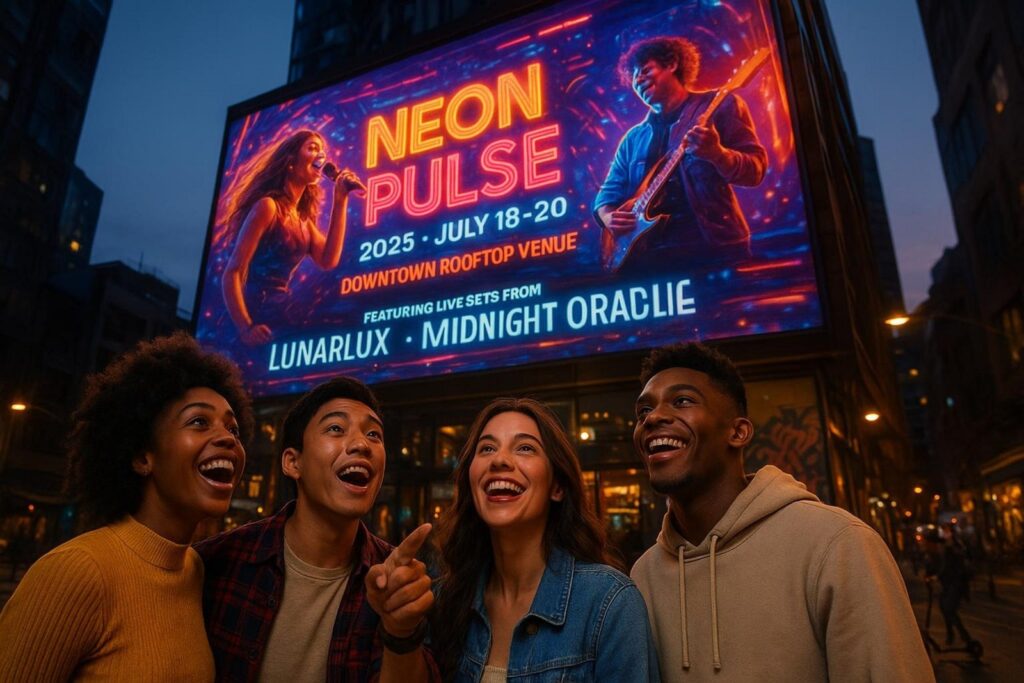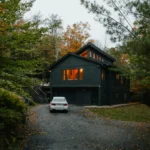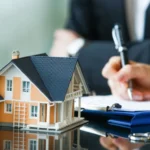Want your business to stand out, literally? Learn how to use effective LED digital screen advertising. LED ads use light-emitting diodes to show bright, moving content that cuts through a sea of static signs. This approach is flexible, bright, and energy-saving, helping your brand get noticed in crowded places.
Unlike static posters, LED screens are easy to see from long distances, which makes them great for busy streets and high-traffic spots. You can update messages often to fit sales, events, or key brand news.
With their strong brightness and clear images, LED ads help businesses get seen and connect with the right people more often.
What Makes LED Advertising Effective for Businesses?
LED ads are more than flashing lights; they are a smart marketing choice with big benefits. Moving visuals and bold colors grab attention better than most traditional signs, helping your message stand out and stick in people’s minds.
How LED Technology Helps Business Marketing
LEDs light up when electricity flows through them. In billboards, millions of tiny LEDs switch on and off fast to show bright images and video. Their high brightness helps your ads stay visible day and night, in sun or rain, across many settings.
LED screens can show high-quality photos, animations, and video. This makes it easier to share your brand story with rich color and detail. Clear visuals help people remember your message and feel more connected to your brand.
Core Benefits of LED Advertising for Brand Visibility
- High brightness and vivid color that catch the eye, even in busy places.
- Fast content updates for timely offers and messages.
- Flexible sizes and formats for stores, malls, events, and large outdoor boards.
- Motion and video that increase recall and help turn quick glances into lasting memories.
- Energy-efficient tech that can lower running costs over time.
Key Differences Between LED and Traditional Advertising Methods
| Feature | Traditional Print Billboard | LED Display |
| Content changes | Needs reprint and manual swap | Update from a computer in seconds |
| Speed of response | Slow and infrequent | Instant updates for offers and events |
| Ongoing costs | Printing, labor, maintenance | Lower energy use, no reprints |
| Content type | Static only | Images, motion, and video |
| Durability | Weather can wear prints | Built for long use with proper care |
Types of LED Displays for Business Advertising
LED displays come in many types to fit different goals and budgets. Knowing the options helps you pick the right setup for your campaign.
Single-Color vs. Full-Color LED Displays
Single-color displays show one color, often red or amber. They work well for simple messages like parking signs, event notices, or time and temperature. They are budget-friendly and clear for basic info.
Full-color (RGB) displays mix red, green, and blue to show a full range of colors. They are best for photos, animations, and video. For ads, full-color screens boost engagement and recall thanks to their rich visuals.
Indoor and Outdoor LED Display Options
Indoor screens use tighter pixel spacing for sharp images at close range. You’ll see them in malls, restaurants, trade shows, and as digital menus where people stand nearby.
Outdoor screens are built to handle weather and be seen from farther away. They use larger pixel spacing and higher brightness for sunlight. Outdoor billboards on streets and highways make bold statements, and their rugged build supports steady performance over time.
For businesses planning to make an impact across both environments, working with BE Media ensures that every display is strategically placed and visually optimized. The agency specializes in matching screen type and location to audience behavior — turning everyday spaces like shopping centers or transit hubs into powerful touchpoints that boost brand visibility and engagement.
Digital Billboards and LED Signs for Businesses
Digital billboards along roads, in cities, and at events offer strong brightness, clarity, and energy savings. They let you manage content remotely for timely, location-aware ads.
Smaller LED signs in storefronts and retail spaces can show promos, new arrivals, or interactive elements to bring people in. Fast content swaps help keep messages fresh and aligned with daily needs.
Pixel Pitch and Resolution: What Fits Your Needs?
Pixel pitch is the distance between the centers of two pixels, measured in millimeters. It affects resolution and the best viewing distance.
- Smaller pixel pitch = more detail, better for close viewing (typical indoors).
- Larger pixel pitch = less detail but high brightness, good for distance (typical outdoors).
Smaller pitch looks sharper but costs more. Match pitch to how far viewers will stand, the clarity you want, and your budget.
How to Choose the Right LED Advertising Solution
Picking the right LED setup takes planning. Think about budget, placement, and who you want to reach so your spend brings good results.
Main Factors: Budget, Location, and Audience
Budget matters a lot. Cost changes with size, pixel pitch, install needs, and extra features. Balance screen quality and impact with what you can spend. A good screen can pay off with better results and lower upkeep and power use over time.
Location is very important. Choose spots that match your business and where your audience spends time. A big screen at a busy junction builds broad awareness. An in-store panel speaks to shoppers on-site. Transit shelters and roadside boards work well for commuters and pedestrians.
Know your audience so your message fits their needs. Look at age, interests, and habits. Schedule different content at different times to reach the right groups throughout the day.
Content Management and Control System Features
A solid content management system (CMS) lets you run screens from anywhere, schedule playlists, and push real-time updates. This makes it easy to react to daily changes.
With a CMS, you can run targeted messages on a schedule across many screens. For example, a restaurant can show happy hour deals at 5 p.m., then switch to live music later. A simple Wi-Fi setup can handle uploads and rollout across several locations, keeping your messages timely and useful.
7 Highly Effective LED Advertising Techniques for Businesses
To get the most from LED screens, use smart tactics that lift engagement and drive action. Here are proven methods you can apply.
1. Dynamic Content Rotation for Maximum Engagement
Rotate several messages instead of showing one static image all day. Change creatives by time, product, or audience. Media owners can also run multiple advertisers on one screen to open extra revenue streams.
2. Targeted Messaging Based on Audience and Location
Schedule content by time of day, day of week, and local events. Study foot traffic and viewer profiles to pick the best moments and places. A coffee shop can show breakfast deals in the morning and switch to afternoon specials later.
3. Real-Time Updates and Adaptive Campaigns
Update promotions, flash sales, or news in minutes. React to weather, local happenings, or competitor moves so your ads stay timely and useful. This is a big step up from slow, one-off print swaps.
4. Dayparting and Time-Based Promotions
Match offers to the time of day. For example: breakfast in the morning, lunch at noon, dinner and happy hour in the evening. Timing boosts relevance and can lift responses.
5. Integrating Interactive and Motion-Based Elements
Use motion graphics and video to hold attention. Short stories, simple animations, or quick clips help people remember your brand and message longer.
6. Data-Driven Personalization and Scheduling
Use mobile and location data to learn where and when your audience moves. Adjust messages and schedules so ads feel more relevant to each group and time slot.
7. Creative Visual Storytelling for Brand Recall
Use bold colors, clear visuals, and short copy to show what your brand stands for. HD video, clean layouts, and smooth color work help people remember you after they pass the screen.

Design Principles for High-Impact LED Content
- High contrast colors for easy reading.
- Short headlines and simple calls to action.
- Large fonts and clean layouts.
- Consistent use of colors, fonts, and logos to build recognition.
- Limit on-screen elements so people can read your message in seconds.
Examples of Innovative LED Advertising from Leading Brands
Big retailers use LED signs to roll out runway looks, promos, and messages across many stores for a unified brand feel. Some brands sync several screens to create the sense of motion across a large area, showing how flexible this medium can be.
Measuring Success: How to Track LED Advertising ROI
LED campaigns should be measured like any other channel. Clear tracking helps you improve and spend wisely.
Metrics to Track Campaign Performance
- Digital impressions: how often ads appear and could be seen.
- Reach and frequency estimates in DOOH platforms.
- Foot traffic near stores after ads run.
- Website visits, app usage, or search spikes tied to flight times.
- Social mentions or engagement after exposure.
- Sales lift or coupon redemptions linked to the screen schedule.
Look beyond counts. Match exposure windows to real actions like store visits or sales. Use these insights to refine creative, placements, and timing.
Testing and Tuning for Better Results
Run A/B tests for headlines, visuals, and calls to action. Try different dayparts or rotation speeds. Keep content fresh, but give each message enough time to be read. Review results often, adjust, and repeat so performance keeps improving.
Common Challenges and Best Practices with LED Advertising
LED screens offer big upside, but there are common hurdles. Knowing them helps you get better results.
Common Pitfalls and How to Avoid Them
- Low-quality visuals: blurry or cluttered designs hurt your brand. Use clean, high-res assets.
- Overloading rotations: too many fast changes can confuse viewers. Give each ad enough time.
- Poor placement: a great screen in the wrong spot won’t perform. Study traffic and audience flow.
- Channel silos: if LED messages don’t match your web and mobile ads, impact drops. Keep brand and offers consistent everywhere.
Environmental and Maintenance Tips
Outdoor screens need regular care: clean panels, check modules, and verify power and network connections. While LEDs need less upkeep than many signs, steady care prevents bigger fixes and keeps performance strong.
LEDs use less power than many older options, which cuts costs and lowers environmental impact. Using energy-saving settings, like auto-brightness that adjusts to daylight, helps even more and supports a greener brand image.
Regulations and Compliance for LED Displays
Before you install any LED screen, check local rules on size, brightness, hours of operation, location, and content. Some cities require permits or limit digital signage in certain zones. Skipping this step can lead to fines or removal.
Talk to local authorities and experienced vendors early to stay compliant. Following the rules from the start saves time and money later.
Emerging Trends: The Future of LED Advertising for Businesses
LED advertising keeps changing with new tech and shifting audience habits. Watching these trends helps you stay ahead.
Integration with Digital Out-Of-Home (DOOH) and Programmatic Advertising
DOOH uses digital screens in public spaces to run timely, context-aware messages. Weather-based ads, transit triggers, and location signals help match content to the moment.
Programmatic DOOH uses automated buying and data to place ads at the right place and time. Real-time auctions and flexible schedules help you reach the right crowd and make better use of your budget.
Eco-Friendly and Energy-Efficient Innovations
New LED chips, smarter power supplies, and auto-brightness controls aim to cut power use while keeping image quality high. Brands that use greener setups can appeal to shoppers who care about sustainability and reduce operating costs at the same time.
Enhanced Brand Experiences with New LED Technologies
New formats like transparent, flexible, and wrap-around LED screens open up creative installs in stores and public spaces. Add-ons like AR and VR can create interactive moments that people want to share, helping campaigns stand out and deliver stronger results.



